Over the years, I’ve been asked countless times if horses can see in the dark.
It’s a question that has intrigued equestrians, horse lovers, and the curious for centuries. I must admit, I believed that horses didn’t possess night vision.
However, I’ve since discovered that they can actually see better than humans in the dark! Now, I’m thrilled to share my knowledge and insights into the fascinating world of horse vision with you all.
Horses have a truly remarkable way of perceiving their environment. From their superior night vision to their ability to detect movement from far away, it’s clear that their visual abilities are nothing short of incredible.
So, let’s dive into the science behind how horses see the world and finally answer the age-old question: can horses see in the dark?
Come along with me as we explore the world through the eyes of a horse!
Table of Contents
Can Horses See In The Dark?
To first answer the original question “can horses see in the dark.” Horses have superb night vision. Horses can see as well as humans on a sunny day if it is a moonlight night or if the stars are out!
However, they cannot see in complete darkness, which can occur when the moon is not visible or when there is extremely dense cloud cover.
Although, it is not typically dark enough for horses not to see.
Now let’s go over a bit more about the basics of horse vision and then more on their experience in the dark.
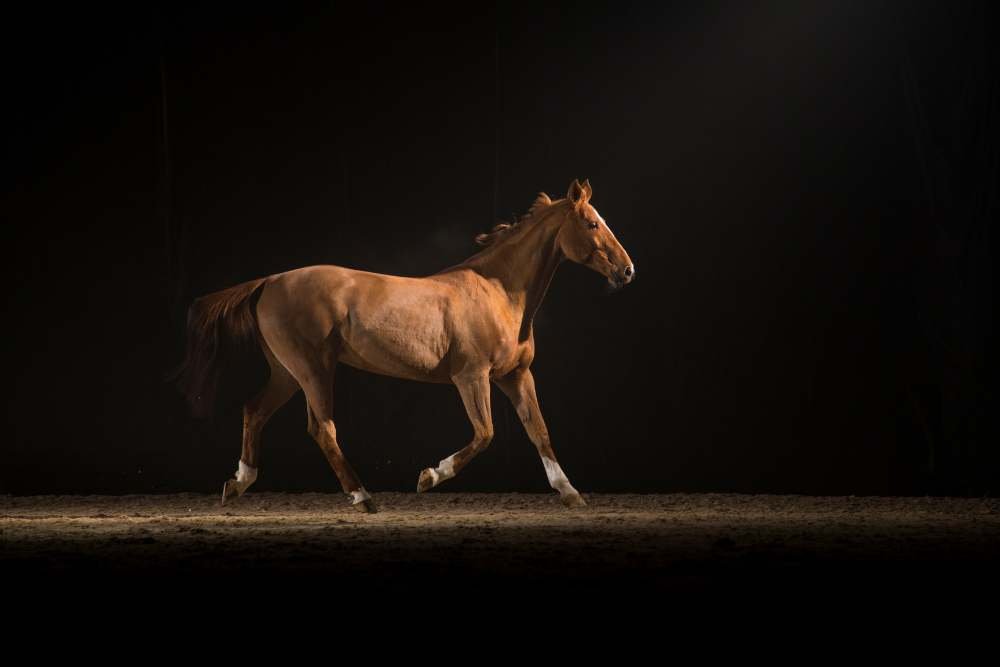
The Basics Of How Horse Eyes See The World
Knowing how horses view the world is essential for everyone who spends time with them. Links
Horses’ eyesight is extremely different from ours, therefore objects and colors seem different to them.
Knowing these distinctions can help you manage horses with knowledge and caution when necessary.
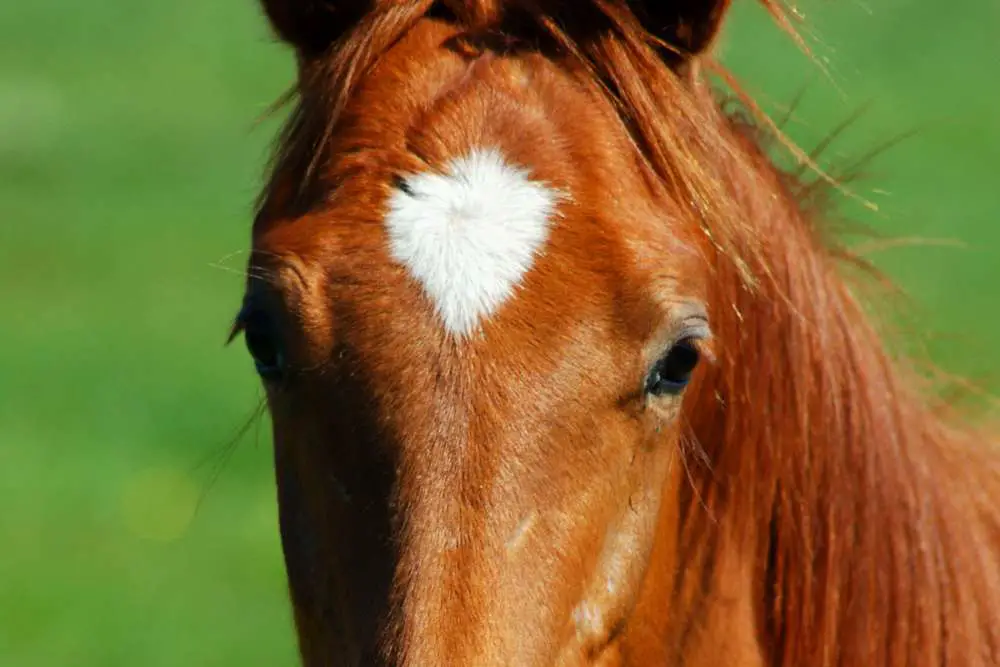
The Horse Has Eyes Of A Prey Animal
Horses have large eyes making it better at tasks that don’t require color, especially when it’s dark, which may help it find predators.
The horse’s eyes are set on either side of their head. This provides them with a wide circular perspective of their surroundings.
Because they are prey animals by nature, this is critical to their existence.
Consider what would happen if horses could only gaze forward and a predator began pursuing them from behind. They would have no idea what was coming unless they heard a twig break or detected a scent of the oncoming danger!
Have you ever noticed how many prey animals have their eyes on the sides of their heads, whilst predators have their eyes at the front?
Their peripheral vision (seeing on the sides of them) enables them to notice movement well.
To protect themselves against incoming dangers, they have evolved to be very alert of any movement on either side of them.
This is also why horses are known as ‘flighty’ creatures. If they remained to look into a strange item or quick movement, they would not survive. Run first, then think! Our horses, thankfully, are domesticated and rely less on these impulses, but they are still present.
Horses have both monocular vision and binocular vision. The horse’s monocular eyesight permits them to see on both sides of their head.
That is, the left and right eyes may act separately and take in various sights (of whatever that eye is pointing towards).
Binocular vision is when a horse utilizes both eyes to perceive what is right in front of them.
This gives them an almost 360-degree vision of their surroundings, making it hard to sneak up on them.
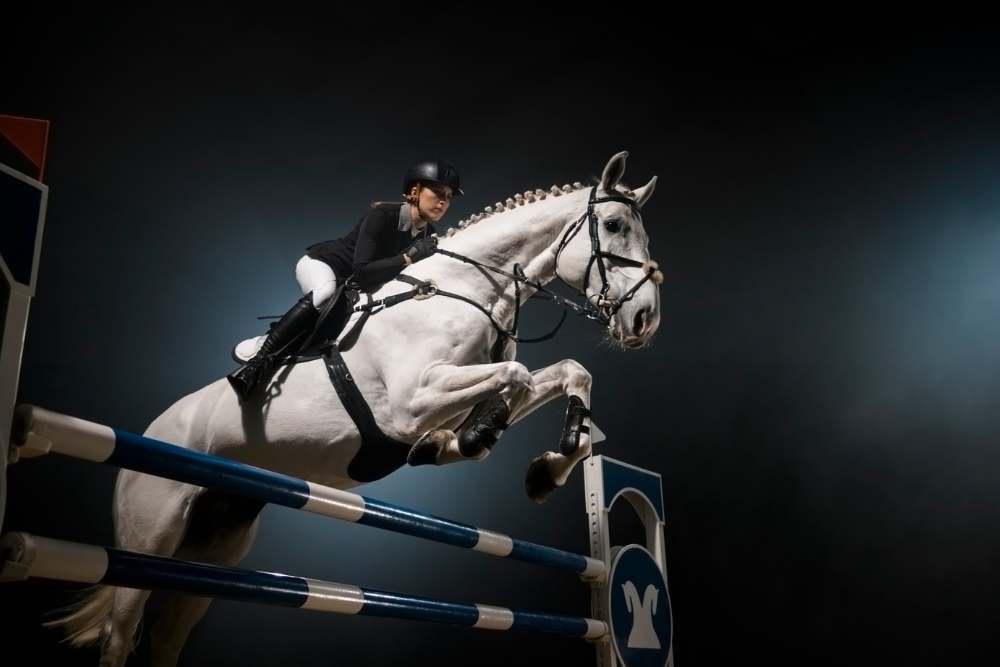
What Is The Horse’s Range Of Vision Like?
Each eye can independently see an arc around the horse’s body of around 200 to 210 degrees.
The horse’s entire field of vision is roughly 300 degrees, aside from 2 small blind spots.
More on that next.
Horse’s Have Blind Spots!
Horses have two blind spots in two distinct locations.
These are three feet ahead of them and six feet behind them. If you consider the forehead, beneath the nose, and at the rear, there are three little blind spots.
Have you ever been warned not to approach a horse from behind? The blind spot behind the horse is the reason.
Yes, horses can kick you, although this is more probable if they are unaware of your presence and are startled.
Because the jump is in their blind spot, jumping horses often turn their heads slightly just before jumping in order to have at least a one-eyed look of the fence they are about to jump.
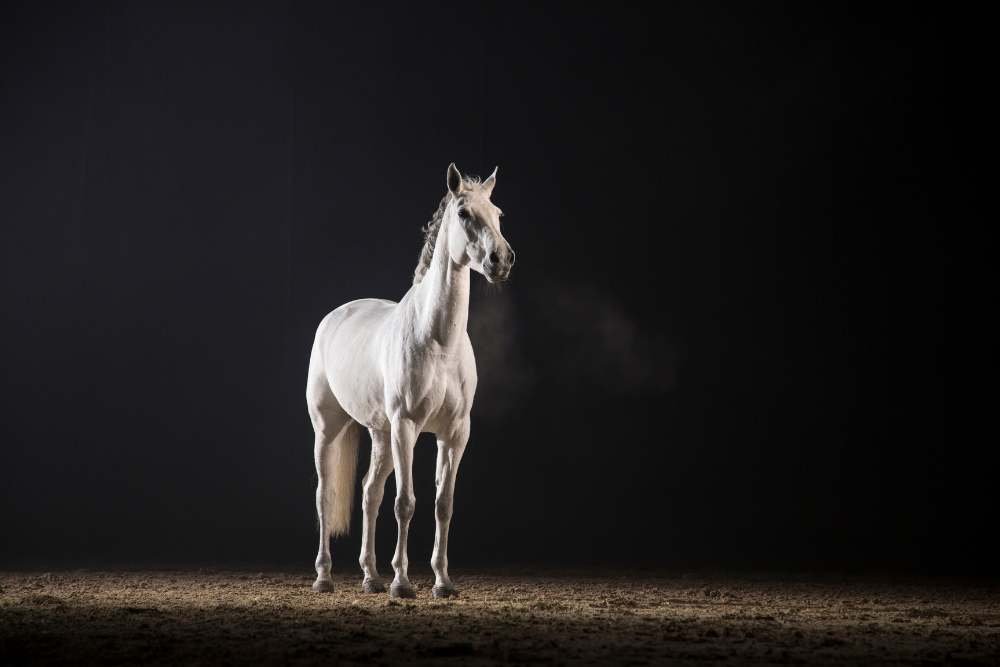
What Is The Horse’s Depth Perception Like?
Depth perception is caused by having two eyes, but even though humans and horses both have two eyes, humans have much better depth perception than horses.
Any eyes can see things, but the brain is needed to understand distance and translate what is being seen. I know this is obvious, but bear with me.
When the two views from each eye are put together, they show the whole picture.
Have you ever tried the trick where you hold out one finger and close one eye at a time?
As you do this, your finger will pop back and forth. This is because your left and right eyes give your brain two different pictures.
Your brain can also tell the difference between these two things in the same way that you can tell the difference between something two feet away and something ten feet away.
Because our eyes are so close together, we can tell how far away something is. The eyes of a horse, on the other hand, are not close together.
That means they do not have a good sense of depth.
When a horse is eating hay, most of what it can see is to its sides and a small part of what it can see ahead.
They can not just look a little to the left with both eyes and know what something is and where it is. Horses do not use their depth perception as much as they use their side vision.
How Far Away Can A Horse See?
About a third of domestic horses are nearsighted, which means they can’t make out features until they are very close to an object.
About 43% of horses are farsighted, which means they can only see details when they are far away from an object.
These differences can affect how well a horse does at certain tasks and how it reacts to things it sees from far away.
The exact range that a horse can see has not yet been determined by scientists.
However, it has been shown that they can perceive visuals from a distance of about 100 yards.
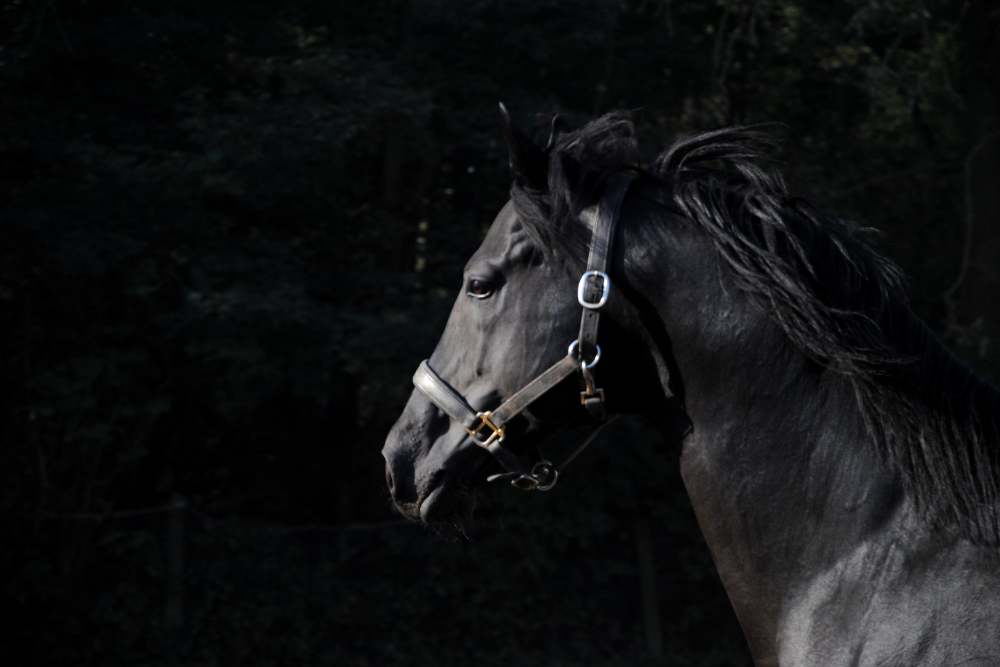
Are Horses Afraid Of The Dark?
Horse’s are not necessarily scared of the dark.
They are awake throughout the night aside from standing naps and a short amount of time lying down for REM sleep, which they also do throughout the day.
Most horses maneuver just fine in the dark.
However what can be scary about the dark for horses is that they are prey animals and predators often stalk their prey in the night. So instinctively they could be more on alert.
They can see objects just fine in the dark, they are not as clear as in the light.
Some horses will have more confidence in the dark than others. However a spooky horse will probably be spooky during the night just as much during the day.
Also horses can be nervous about going into the dark from a lighter area.
Though they can see things in the dark that people can’t.
They aren’t well-suited to change quickly from bright light to dark, because they would be seeing blackness until their eyes adjust, sometimes resulting into bumping into things or tripping. This can scare them, make them want to get away and give them a bad association with walking into darker areas.
Some examples of when this can happen:
- walking from outside to inside the barn
- walking from a bright aisle to a dark stall
- walking into a dark trailer
- walking from a bright indoor arena to the nighttime darkness outside
Overall, horses can sometimes be scared of the dark because they are more on alert as prey animals or because of bad experience with walking into a dark area from a bright area and eyes taking a while to adjust to the darkness.
Many horses will not be afraid of the dark at all, especially if they are used to living outside and careful about how they move around when they go into darkness from a bright area.
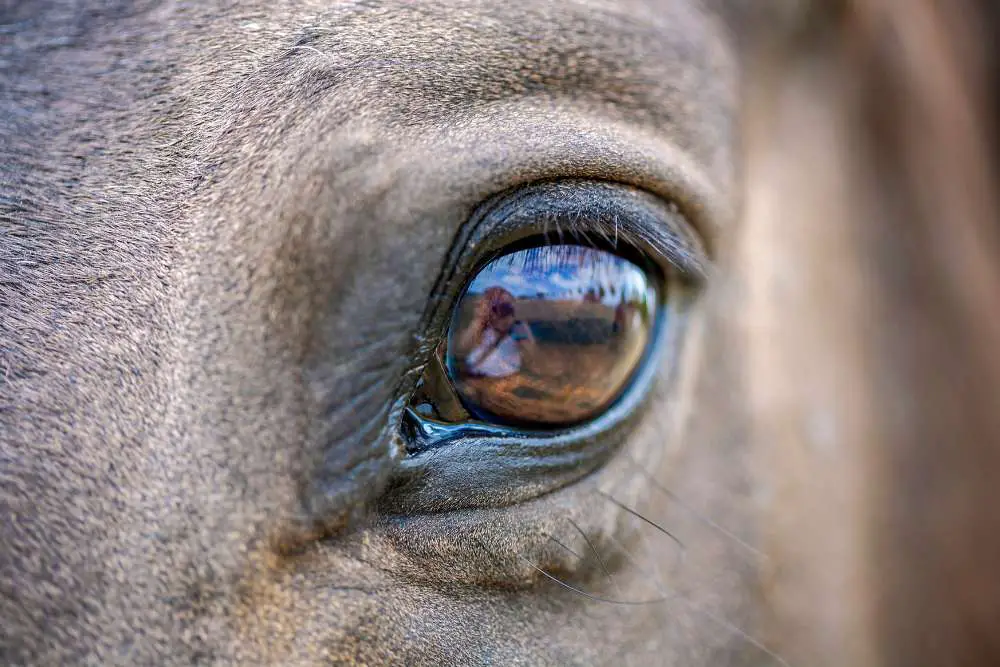
Anatomy Of Horses Eyes Used For Seeing In The Dark
Horses have huge pupils and large eyes. Even in the dark, this permits a lot of light to penetrate the eye.
The tapetum lucidum is a membrane located at the rear of the equine eye. You may see a blue grey shine or a line around the eye, that is it.
I noticed this on one of my horses, a Thoroughbred named Storm, more than on any other horse I’ve worked with or owned, and I’ve always wondered what that bluish-grey line was at the back of his eye, as well as why the pupil sometimes looked blue-grey. I didn’t know what it was until I did some research on horse eyes and vision.
I often feared that he was going blind, but thank goodness that wasn’t the case, it was just the tapetum lucidum (located at the back of the retina).
This aids the horse’s eye in improving visual sensitivity in low light levels and is not found in the human eye.
Horses have a high proportion of rods. The proportion of rods to cones is 20:1.
Cones are responsible for color vision, whereas night vision capabilities are determined by rods. The rods are what allows the horse to see at night.
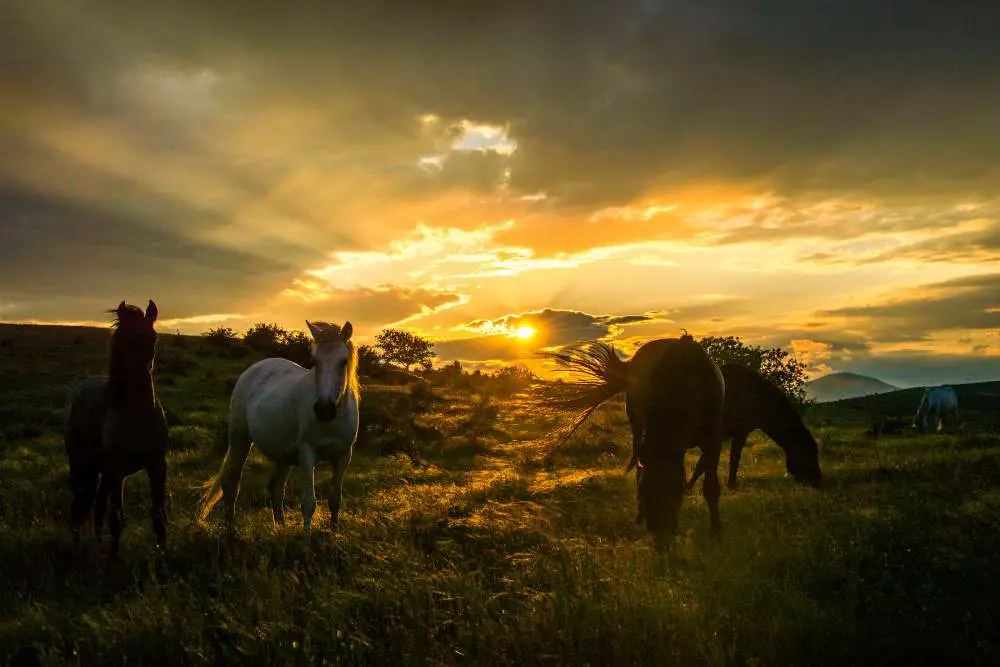
How Well Is A Horse’s Night Vision?
Horses have excellent night vision. They can see well in low light conditions, whether illuminated by a full moon or a starry sky.
This only applies to horses with normal eyesight and vision.
Night blindness affects certain horses. Read on for more information!

How Long Does It Take For A Horse’s Eyes To Adjust To Darkness?
When a horse moves from two differently lighted areas, such as from bright light to dim light, it takes around 15 minutes for their vision to adapt.
This can make them startle when they go into or out of a barn when the lighting outside is different. Allow your horse’s eyes to adapt by carefully walking them out of your bright barn into the dusk light.
I have seen horses struggle to get into a dark barn, stall, or indoor arena when the sun is shining outside.
Most of the time, the horses stand still for a second because they can not see and are giving their eyes time to adjust. When a horse is scared in this situation, it often moves around and bumps or bangs into something, which can hurt it.
Even when they go from a dark area to a bright area, the horses squint and try to adjust to the change in lighting, just like you would. However, it seems to take them longer.
So, when you are working with horses, it is important for both your safety and theirs to be aware of changes in the lightning.
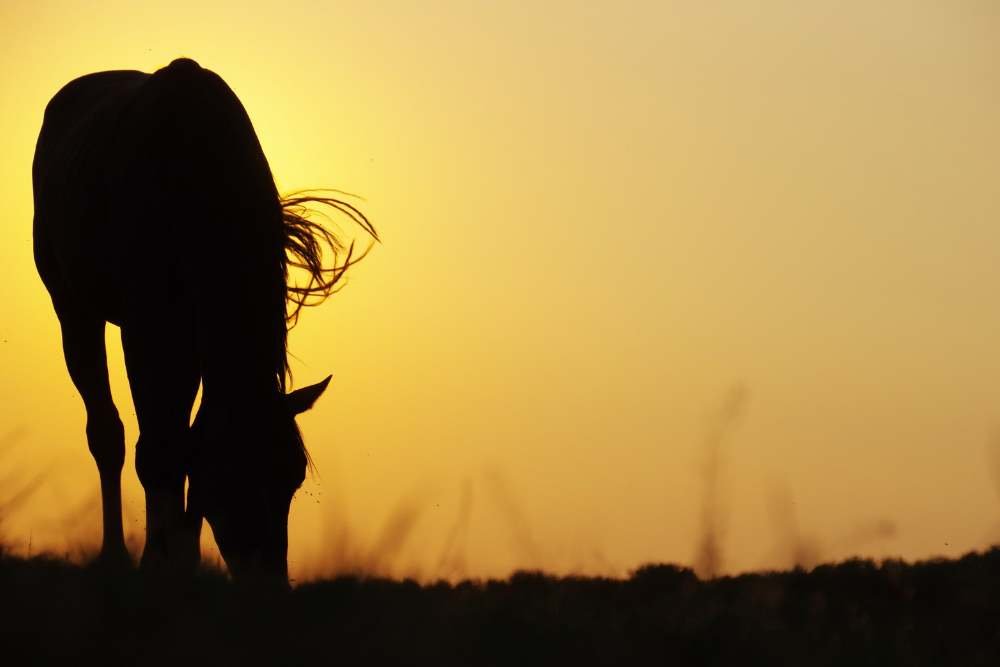
How Is A Horse’s Vision Different Than A Human’s In The Dark
Horses see much better than humans at night and in the dark.
Studies have shown that horses have excellent vision in dim light, such as dusk, which gives them an advantage over humans.
Although they may have difficulty distinguishing shapes or objects in complete darkness, they are still able to navigate their surroundings with ease and outperform their human counterparts.
The tapetum lucid membrane is present in both humans and horses, but the horse’s membrane is significantly more powerful.
Earlier, the terms ‘cones’ and ‘rods’ were mentioned, with horses having a large number of rods that aid with night vision.
It is the other way around for people. Because we have more ‘cones,’ we can perceive a wider variety of colors. And in the sense of colors we have trichromatic vision, while while horses have dichromatic color vision.
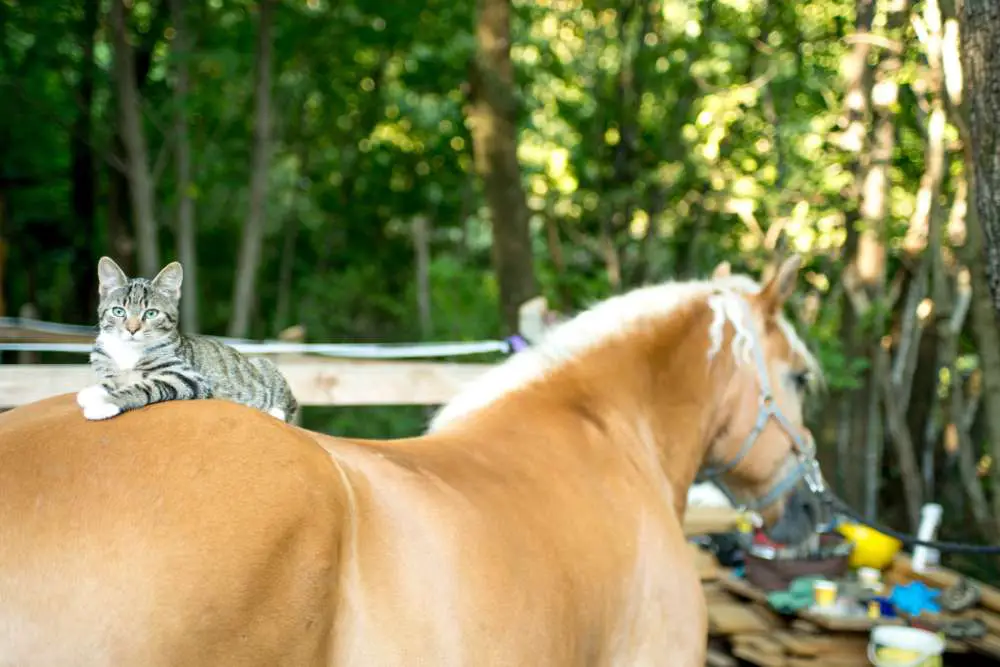
How Is A Horse’s Night Vision Compared To A Dog Or Cat?
The night vision of a horse is superior to that of a person but not as advanced as that of a dog or cat.
Dogs and cats, or their predecessors who hunt at night, are predators. To complete their mission, they must have exceptional night vision.
Dogs and cats, like horses, have a lucid tapetum at the rear of their eye. This is what gives your pet’s eyes a metallic sheen at night when a light is shone on them.
Cats would always win a match between cats and dogs to test who had better night vision. Our feline companions have excellent low-light eyesight.
What Colors Can Horses See In The Dark?
Because horses only have blue-sensitive cone cells and yellow-sensitive cone cells, they can only see blue, green, and their variations. This kind of vision is called dichromatic.
Horses can’t see the color red or tell it apart from other colors. It’s also said that horses probably can’t see any shades in between (colors between the primary colors).
And because horses have great night vision, colors don’t change much from day to night.
According to research, their color vision is similar to red-green color blindness in humans, in which some colors, particularly red and related colors, seem more green or yellowish.
Horses can see things best when their colors are different from the ground.
This is one of the main reasons why horse jumps are so colorful and painted: it helps the horse pay more attention to them and jump with more accuracy.

Can You Ride A Horse In The Dark?
Yes! Many riders are hesitant to ride their horses at night because they do not know how well their horse’s vision is after dark.
If the rider uses a flashlight or headlight, some issues may arise. The sudden shift in brightness may frighten the horse.
If the rider can not see very well, steer clear of regions that require hard navigation or are densely forested.
Although, dense woods and those rare nights when it’s pitch black aren’t good places to ride, if you let your horse choose his own path in familiar surroundings, your horse can navigate well enough to get around.
So if there is bright moonlight and you have missed your ride for the day, tack up and go on an adventure!
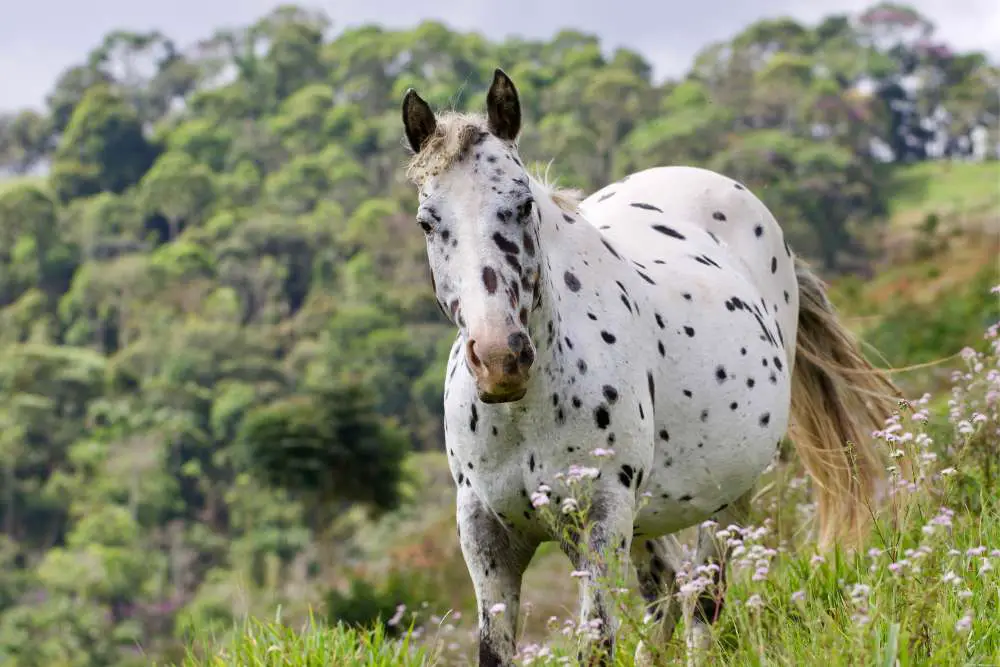
What Breeds Of Horses Typically Carry Genetic Night Blindness?
The inability to see in low- or no-light situations is known as Congenital Stationary Night Blindness (CSNB) also known as moon blindness. It causes abnormal signals to be sent from the rods to the visual pathway cell.
As the name “night blindness” implies, they are unable to see anything at night or in the early evening/morning.
Horses with two copies of a particular white spotting pattern mutation have CSNB.
This is referred to as leopard complex spotting. Appaloosas, Knabstruppers, and Miniature Horses have this coat pattern (along with some other breeds).
If you have one of these breeds and believe they may be a night blind horse, it is critical that you have it checked out.
Night blind horses should be housed in a well-lit place, such as a barn or a fenced-in shelter with a lamp.
Consider how terrified you would be if you were blinded and subjected to loud noises; now imagine doing that with a gigantic flight animal! It has the potential to go horribly wrong.

Can Horses See At Night With A Fly Mask On?
When it comes to horse care, owners must determine if a fly mask should be worn by their horse at night.
The answer is not always obvious, since it is dependent on the particular horse’s condition and demands.
In general, horses do not need a fly mask at night and are typically safer without one.
Horses with eye issues or who are extremely sensitive to flies, on the other hand, may be encouraged by their veterinarian to wear a fly mask at night.
While a fly mask does not impede eyesight during the day, it does degrade vision slightly in the dark.
Since a result, it is critical to exercise additional caution while releasing horses at night while wearing a fly mask, as they may be more prone to harm owing to their somewhat decreased vision.
Finally, the optimum course of action for each horse will be determined by its specific needs and should be reviewed with a veterinarian.
Finally, it is generally suggested that horses do not wear fly masks at night since they might impair their vision and increase the danger of damage.
Horses with eye issues or who are very sensitive to flies, on the other hand, may benefit from wearing a fly mask at night, however they should be properly observed when out in the dark.
Finally, each horse’s best course of action should be addressed with a veterinarian.
Do Horses Sleep At Night?
Horses, like humans, sleep at night, but they also sleep during the day.
Horses are classified as polyphasic sleepers. That implies they sleep many times every day. However, the majority of their sleep occurs at night.
It is often assumed that horses exclusively sleep standing up. While horses may sleep standing up utilizing the stay equipment, they must lie down to obtain full REM sleep.
They just require 30 to 60 minutes of REM sleep every day. They take the rest of their naps standing up.
So now hopefully you will be at rest when your horse is outside at night in the dark.
Cheers, Kacey
P.S. Did you like this article? Gallop over to:

